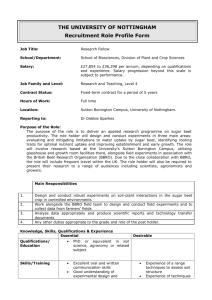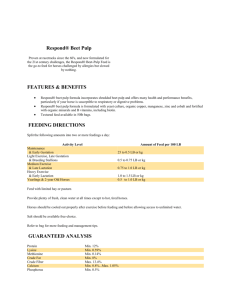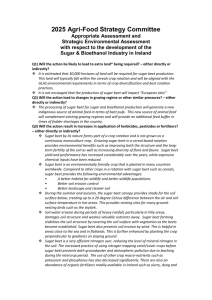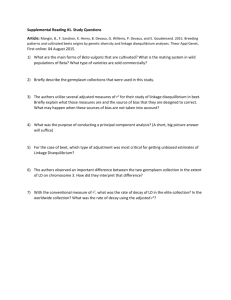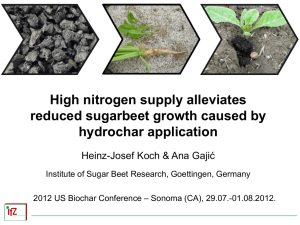THE FARM SCALE TRIALS WITH GENETICALLY
advertisement
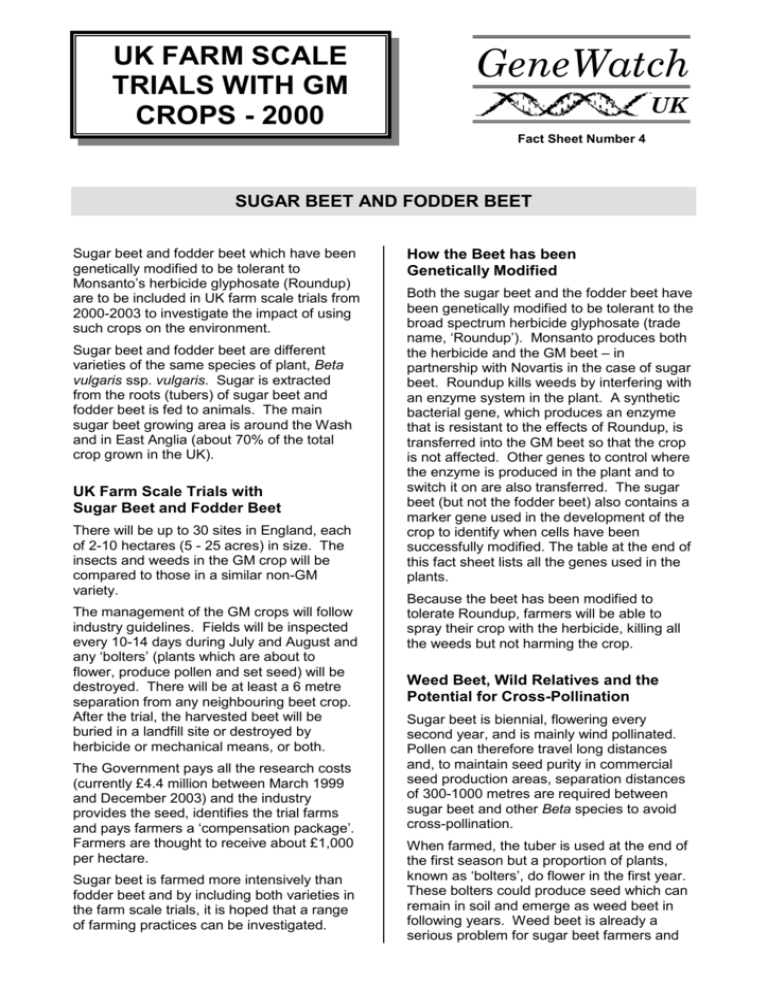
UK FARM SCALE TRIALS WITH GM CROPS - 2000 GeneWatch UK Fact Sheet Number 4 SUGAR BEET AND FODDER BEET Sugar beet and fodder beet which have been genetically modified to be tolerant to Monsanto’s herbicide glyphosate (Roundup) are to be included in UK farm scale trials from 2000-2003 to investigate the impact of using such crops on the environment. Sugar beet and fodder beet are different varieties of the same species of plant, Beta vulgaris ssp. vulgaris. Sugar is extracted from the roots (tubers) of sugar beet and fodder beet is fed to animals. The main sugar beet growing area is around the Wash and in East Anglia (about 70% of the total crop grown in the UK). UK Farm Scale Trials with Sugar Beet and Fodder Beet There will be up to 30 sites in England, each of 2-10 hectares (5 - 25 acres) in size. The insects and weeds in the GM crop will be compared to those in a similar non-GM variety. The management of the GM crops will follow industry guidelines. Fields will be inspected every 10-14 days during July and August and any ‘bolters’ (plants which are about to flower, produce pollen and set seed) will be destroyed. There will be at least a 6 metre separation from any neighbouring beet crop. After the trial, the harvested beet will be buried in a landfill site or destroyed by herbicide or mechanical means, or both. The Government pays all the research costs (currently £4.4 million between March 1999 and December 2003) and the industry provides the seed, identifies the trial farms and pays farmers a ‘compensation package’. Farmers are thought to receive about £1,000 per hectare. Sugar beet is farmed more intensively than fodder beet and by including both varieties in the farm scale trials, it is hoped that a range of farming practices can be investigated. How the Beet has been Genetically Modified Both the sugar beet and the fodder beet have been genetically modified to be tolerant to the broad spectrum herbicide glyphosate (trade name, ‘Roundup’). Monsanto produces both the herbicide and the GM beet – in partnership with Novartis in the case of sugar beet. Roundup kills weeds by interfering with an enzyme system in the plant. A synthetic bacterial gene, which produces an enzyme that is resistant to the effects of Roundup, is transferred into the GM beet so that the crop is not affected. Other genes to control where the enzyme is produced in the plant and to switch it on are also transferred. The sugar beet (but not the fodder beet) also contains a marker gene used in the development of the crop to identify when cells have been successfully modified. The table at the end of this fact sheet lists all the genes used in the plants. Because the beet has been modified to tolerate Roundup, farmers will be able to spray their crop with the herbicide, killing all the weeds but not harming the crop. Weed Beet, Wild Relatives and the Potential for Cross-Pollination Sugar beet is biennial, flowering every second year, and is mainly wind pollinated. Pollen can therefore travel long distances and, to maintain seed purity in commercial seed production areas, separation distances of 300-1000 metres are required between sugar beet and other Beta species to avoid cross-pollination. When farmed, the tuber is used at the end of the first season but a proportion of plants, known as ‘bolters’, do flower in the first year. These bolters could produce seed which can remain in soil and emerge as weed beet in following years. Weed beet is already a serious problem for sugar beet farmers and herbicide tolerant weed beet could, over time, severely exacerbate the situation. GM sugar beet and fodder beet bolters could also easily cross-pollinate their wild relative, sea beet (Beta vulgaris ssp. maritima), and result in fertile seed being produced. According to a DETR research report, sea beet “.. occurs most commonly on tidal drift lines in the higher parts of saltmarshes or on shingle beaches and is also found on coastal cliffs and sea walls. It is a common constituent of the vegetation on earth embankments and estuarine river banks in East Anglia, often growing within a few metres of sugar beet crops....” The same report considers the probability of gene flow to wild relatives to be ‘high’. In Europe, there is evidence that gene flow between conventional sugar beet and wild beet has already led to problem weeds emerging. Some scientists argue that transfer of the herbicide tolerance gene to wild relatives is not important as it will not give a competitive advantage except in the presence of herbicide and that other herbicides can be used to destroy weeds should they emerge. Concerns about the Trials The farm scale trials are being presented by Government and the industry as addressing all the outstanding issues. However: The trials are short term and may not identify long-term, cumulative environmental impacts. Bolters may be removed during the experiments but not when grown commercially – giving a false impression of safety. How cross-contamination of neighbouring conventional and organic crops will be handled in the long term is unclear. British Sugar currently do not accept GM sugar beet for processing and no market may exist in the future. As yet, there are no regulations addressing the safety of feeding GM crops to animals. Sugar from GM sugar beet would not be labelled under current regulations.. The genes transferred into sugar beet and fodder beet Gene Function Present in Figwort mosaic virus promoter Switches on the herbicide tolerance gene (CP4 EPSPS). Sugar beet & fodder beet Chloroplast transit gene from the plant, Arabidopsis A gene that directs the production of the herbicide tolerance protein to the chloroplast – a part of the plant cell. Sugar beet & fodder beet Synthetic CP4 EPSPS gene Makes the plant tolerant to the herbicide glyphosate (Roundup). Sugar beet & fodder beet E9 3’ gene from the pea plant Increases the activation of the herbicide tolerance gene (CP4 EPSPS). Sugar beet & fodder beet Cauliflower mosaic virus p-E35S gene Switches on the GUS marker gene. Sugar beet only GUS gene from the bacteria, E.coli A selectable marker gene to show when genetic modification has been successful. Codes for an enzyme which breaks down certain chemicals to give a detectable colour change. Sugar beet only Partial GOXsyn gene from a bacterium Non-operational. Sugar beet only GeneWatch UK, The Mill House, Manchester Road, Tideswell, Buxton, Derbyshire, SK17 8LN Phone: 01298 871898 Fax: 01298 872531 Email: mail@genewatch.org Website: www.genewatch.org Printed and Published by GeneWatch UK – August 2000
